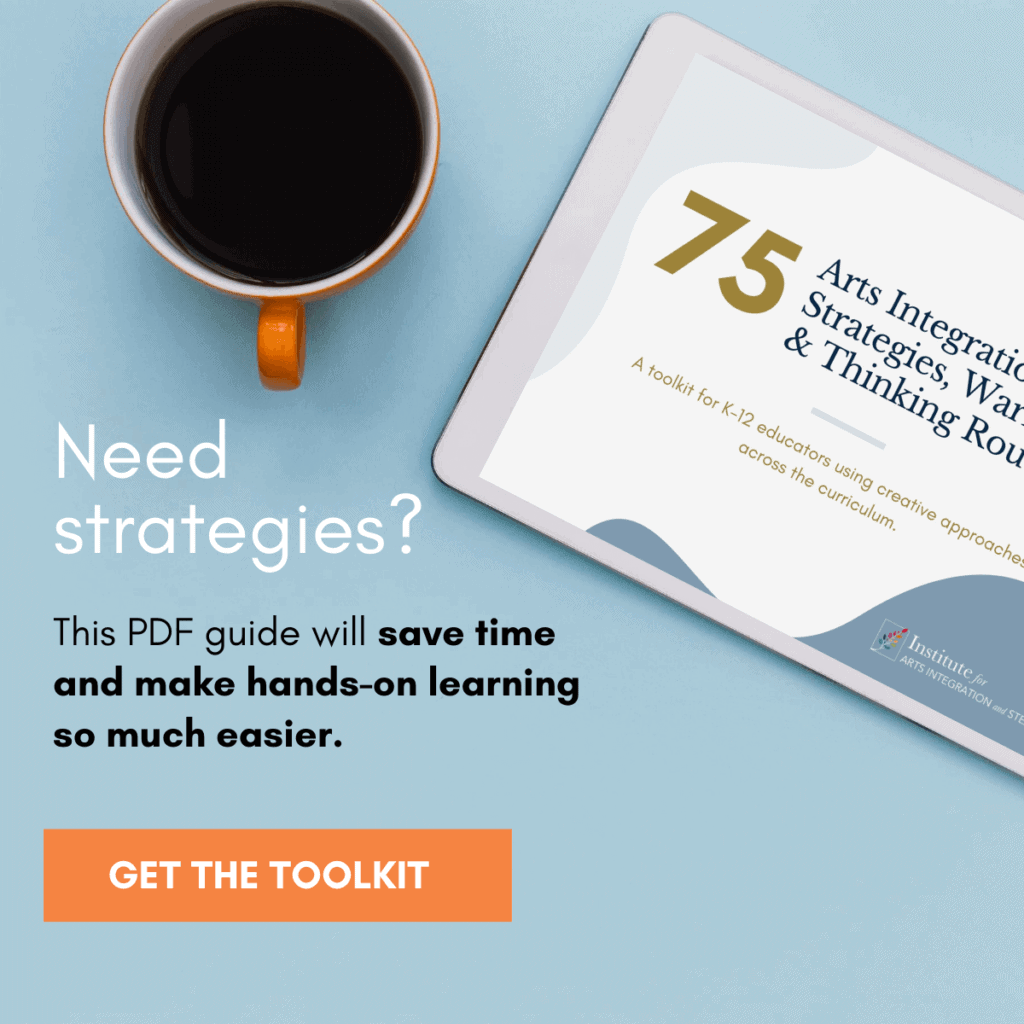Arts Integration and STEAM Implementation Guide
3 Min Read • Planning
When it comes to arts integration and STEAM implementation, the details make all the difference. There’s actually a pretty clear sequence to bringing an integrated approach into your classroom, school or district. So here are 5 steps you can use to make this process accessible to all teachers in all classrooms.
1. Strategies
I’m a big advocate for starting with strategies first. Why? Because these provide a “quick win” for teachers and students. They’re also easy to use as a way dip your toe into integrating the arts. Here are some key ideas to keep in mind:
- Explore various strategies in visual art, music, dance and theater.
- Select 2-3 strategies you would like to try.
- Implement the strategies as warm-ups or at specific points in your regular lessons where they make sense.
- Use selected strategies consistently.
2. Standards Alignment
Standards alignment is what separates a true, authentic arts integration or STEAM lesson apart from arts enhancement. Furthermore, it’s being intentional about looking for standards across content areas that make a natural fit and pairing them together. You then use these paired standards to design an integrated lesson. Once you’ve had some success with using integrated strategies, it’s time to take a look at content and arts standards. Here’s how:
- Review your curriculum documents and identify 2-3 areas for integrated lessons.
- Review the standards addressed in your content areas for these lessons and connect with arts educators to find naturally-aligned standards in their arts areas.
- Create curriculum maps that align these standards.
3. Lesson Delivery
After you’ve used arts integrated strategies and your standards are mapped out, you can move into lesson design and delivery. In this process, you’re creating a lesson that teaches both of the standards you’ve selected. The key here is to pivot between both content areas equitably – neither is being used in service of the other. And good quality lesson design is a must: having a “hook” (most likely your strategy), followed by clear steps that build upon each other, multiple checks for understanding, smooth transitions built in and a solid assessment. Here’s a few more things to think about:
- Use planning documents to create an integrated lesson.
- Open your lesson with a strategy that helps to connect your two standards.
- Deliver your STEAM or Arts Integration lesson.
- Create and deliver 2-3 lessons throughout the year
4. Assessment
This is a big step! Assessing integrated lessons can be overwhelming if you don’t understand the assessment process. Remember that assessing a standard is simply looking for growth from beginning to end. Evaluation is a judgment of mastery. In an integrated lesson, we’re looking for assessment and not evaluation. Evaluations are left to the content teacher and fine arts specialists. However, it’s important to understand that if you teach something, you must assess it. Therefore, equitable assessments for both sets of standards are necessary for an arts integration or STEAM lesson to be complete.
- Create assessments for each STEAM lesson that assess both the content and arts standards addressed in each lesson.
- Review the assessments to see how students did and compare trends over time.
- Compare your integrated lesson assessments with assessments from non-integrated lessons on the same topic. Document your findings.
5. Extension
Once you’ve got the integration process down, now it’s time to support it for the long term. It’s one thing to do a few arts integration or STEAM lessons. But it’s a whole other thing to make this a part of the culture in your school. To move in that direction and truly create an arts integration or STEAM school, you need to have a plan to make this sustainable. Here are some ideas you can try:
- Identify ways that local businesses and organizations can support or provide resources for integrated lessons.
- Host a parent night or STEAM gallery
- Build a small team of teachers who would like to try this together.
And there you go! That’s the beginning of shifting to arts integration and STEAM implementation. If you’re looking for more on this topic, check out the Designed to STEAM online course. This whole topic is covered in a lot more detail and you’ll create your own implementation plan to make this meaningful for your own school.




